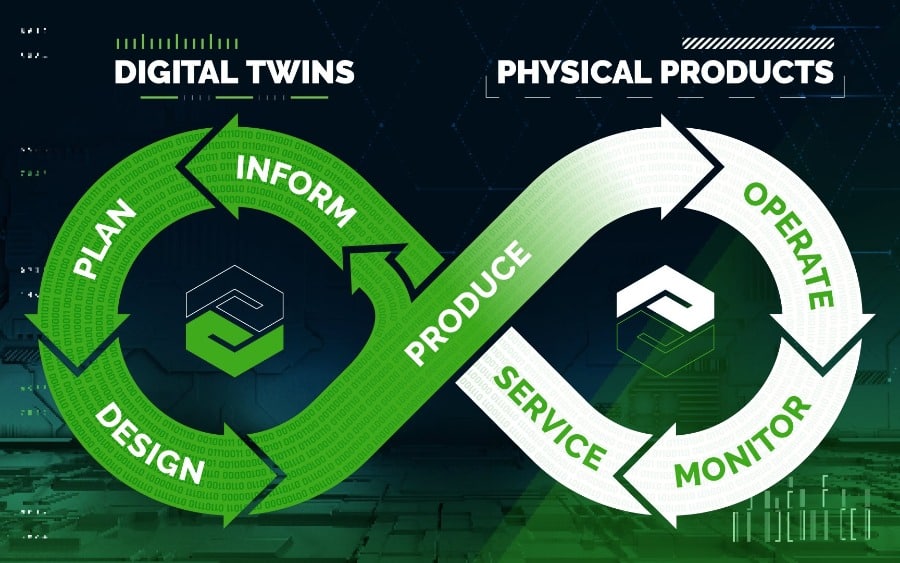2020 is predicted to be a huge year in the progression of digital transformation and Industry 4.0. Organizations in all industries are taking steps to implement digital transformation strategies in their operations. However, with so much discussion and hyped expectations, many manufacturing companies are left wondering how these changes are going to impact them. For a better understanding, we have compiled the top 2020 digital transformation trend predictions, so you know what to expect.
According to IDC Research, companies are predicted to spend more than $7 trillion on digital transformation over the next three years.
ThingWorx Manufacturing Apps
Vuforia Studio
Windchill PLM
Creo
Vuforia Chalk
2020 Digital Transformation Trends
Shift from Testing to Implementation
Many manufacturing organizations have had digital transformation pilot programs in place for a few years – and if you don’t, then you are likely falling behind your competitors. 2020 is expected to be the year that many of these programs switch from ongoing tests to full implementation. The latest solutions have become reliable enough for implementation on a wider scale and more teams have become comfortable with using these platforms. The next step after implementation will be finding additional ways to provide customer value on a large scale.
Digital transformation technology has matured to have the reliability required to implement across operations.
Optimizing Processes to Support Digital Transformation
When retail companies first launched their online efforts, everything operated in a silo. Customers weren’t always able to find items online after seeing them in stores, and online purchases couldn’t be returned to physical stores. This way of operating was awkward for customers and expensive for companies. Since then, they have revamped their processes to integrate both physical and online presence to provide a smooth experience. Now, why does this matter to manufacturers? Because these organizations need to think about their own internal processes in a similar way.
For example, it doesn’t make sense for a digital interface to be separate from the interface placed on a product. So the UIs shouldn’t be designed by different teams. Customers want seamless experiences from your products and your services. They don’t want multiple invoices for digital and physical products or to have to decide between a variety of support options. Customers view you as a single organization, so they expect a single way to interact. This means manufacturers need to break down the invisible walls between departments to provide streamlined services.
It’s time for manufacturing organizations to break down departmental walls and provide a single seamless experience for their customers.
Investing in People and Training
 Even though 2020 digital transformation trends tend to focus on tools and solutions, ultimately it’s people at the core of the transition. However, the evolution of manufacturing has not kept pace with the skills of the existing workforce, and with unemployment at an all-time low, it’s even harder to fill critical positions.
Even though 2020 digital transformation trends tend to focus on tools and solutions, ultimately it’s people at the core of the transition. However, the evolution of manufacturing has not kept pace with the skills of the existing workforce, and with unemployment at an all-time low, it’s even harder to fill critical positions.
Manufacturers need to retrain their existing employees to have the skills needed in today’s environment. One trend will be investing in retraining existing employees. In addition, manufacturing organizations will also be tasked with presenting their work as a viable and fulfilling career to keep the workforce alive as existing workers begin to retire.
Effectively Using Smart Products
Digital transformation has moved beyond the initial tools and platforms that helped enable its beginnings – but that doesn’t mean they aren’t still important. One of the biggest 2020 digital transformation trends will be moving beyond simply increasing productivity between processes and personnel and toward the reimagining of products and a recasting of company offerings.
Manufacturing organizations will need to determine how to use smart products to eliminate non-value steps for customers.
Aligning Business and Digital Strategies
The reimagination of products and offerings must occur at a strategic level and focus on the customer, not just internal business needs. Teams will need to determine how to digitize the most important features of products, which in many cases will be completely new aspects that never existed before. The goal of 2020 digital transformation trends is to solve problems for customers in ways that benefit them.
2020 digital transformation trends focus on how organizations can improve customer experiences rather than internal goals.
Ongoing Transformation Journey
 Manufacturers must adopt a continuous improvement mindset when it comes to digital transformation goals. Implementing these strategies is not a one-and-done project. Organizations should focus their efforts in one area and do it well. The best place to start is by optimizing and improving an existing pilot project and determining how you can expand its scope to a slightly larger or adjacent area.
Manufacturers must adopt a continuous improvement mindset when it comes to digital transformation goals. Implementing these strategies is not a one-and-done project. Organizations should focus their efforts in one area and do it well. The best place to start is by optimizing and improving an existing pilot project and determining how you can expand its scope to a slightly larger or adjacent area.
The key is to not try to tackle too much at once. Don’t try to implement a ton of small projects that don’t generate much impact. Look beyond your current scope and work with a variety of people – customers, competitors, futurists, etc. – to help you transform your physical products into digital ones.
Don’t get overwhelmed with too many goals, but don’t wait for perfection to a point where you get left behind.
Find a Partner to Help You Move Forward with 2020 Digital Transformation Trends
When it comes to 2020 digital transformation trends, there is no one way to get it right. You must consider:
- How your organization operates
- The tools you currently have
- The platforms you want to implement
- Long-term business goals
To effectively move forward with your digital transformation, we recommend finding a partner like 3HTi who can help you navigate this complicated but exciting landscape. We have extensive knowledge of the supporting technologies required to make digital transformation work, and we understand how they can benefit your organization. For more information or if you have questions, fill out the form below.

